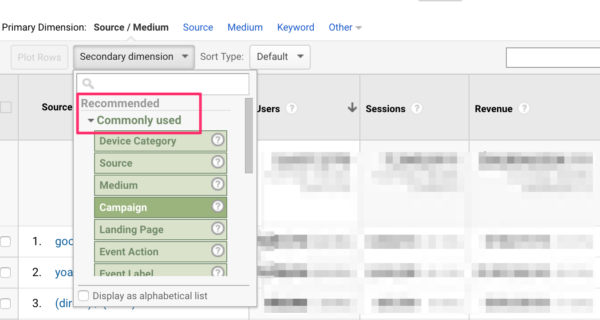Enhance Your Data Analysis Making Use Of Second Measurements
In the realm of information analysis, key metrics often offer a foundational understanding of performance or patterns. Nonetheless, truth depth of insights depends on the combination of secondary dimensions. These extra layers of data use a nuanced sight that can decipher complexities and subtleties not noticeable at very first glimpse. The capability to dissect information with numerous lenses opens up doors to a realm of possibilities that can change just how companies act and interpret upon their information. The critical use of secondary dimensions elevates analysis beyond the surface level, guaranteeing a wide range of untapped possible waiting to be found.
Comprehending Second Dimensions
Additional measurements in information analysis describe extra attributes or metrics that provide deeper insights when incorporated with key data dimensions, boosting the general understanding of the dataset. These extra measurements offer a more thorough sight of the information, permitting analysts to uncover concealed patterns, connections, and patterns that might not appear when only thinking about primary measurements.
By integrating second dimensions into data evaluation, experts can gain a more nuanced understanding of the aspects affecting the main metrics. In marketing evaluation, main measurements might include fundamental client demographics like age and gender, while additional dimensions might encompass variables such as buying actions, preferences, or geographical location. By integrating these key and additional measurements, analysts can produce much more in-depth client accounts, allowing even more targeted and efficient advertising and marketing methods.
Furthermore, secondary dimensions can assist in determining connections between various variables, bring about even more precise predictive modeling and decision-making. They allow analysts to discover information from several viewpoints, enhancing the understandings attracted from the dataset and inevitably improving the quality of analysis and strategic referrals.
Advantages of Secondary Measurements
When thinking about information evaluation, including second measurements supplies a wide variety of benefits that considerably enhance the deepness and breadth of insights stemmed from main information measurements. One of the key advantages of second dimensions is the capability to provide context to main data. By adding additional dimensions such as time, location, or demographic information to the evaluation, researchers can acquire an extra thorough understanding of the key data points - secondary dimensions. This contextual info can assist recognize patterns, fads, and connections that may have or else gone unnoticed.
Furthermore, second dimensions can also help in segmenting information, enabling for a much more in-depth evaluation of details subsets within the primary data. This division can result in even more targeted techniques and actions based upon the distinct features of each segment. Additionally, secondary dimensions can assist in confirming searchings for from main data dimensions, offering an extra durable and trustworthy basis for decision-making.
Basically, the benefits of incorporating second dimensions into information evaluation are very useful, providing richer understandings and making it possible for even more enlightened decision-making procedures.
Executing Secondary Measurements Efficiently
When including secondary dimensions, it is crucial to align them with the key dimensions to acquire deeper insights into the data. It is crucial to pick secondary dimensions that enhance the primary information without creating noise or confusion in the evaluation.
Furthermore, consider the scalability of the second measurements across various datasets or analyses. By carrying out second dimensions effectively, analysts can boost Web Site the deepness and accuracy of their data evaluation, leading to more educated decision-making and workable insights.
Advanced Techniques With Secondary Dimensions
For a much more sophisticated method to information analysis, integrating additional measurements can dramatically raise the deepness of understandings gained. Advanced strategies with secondary dimensions involve even more intricate techniques to draw out beneficial details from information sets.
Another innovative technique is regression analysis, which helps determine relationships in between variables and how they impact each various other. By adding additional measurements, such as market information or user actions, to regression versions, you can discover more nuanced understandings and make more accurate predictions.

Study: Second Measurements at work

In one more scenario, a healthcare provider leveraged second measurements to maximize source appropriation. By evaluating individual results in relation to geographical area, the organization determined locations with high readmission rates. This caused the application of targeted treatment programs in those areas, eventually boosting person care and lowering medical care expenses.
These study illustrate the power of second you can find out more dimensions in revealing useful understandings that drive calculated decision-making. By diving deeper right into data analysis beyond primary metrics, organizations can gain a much more comprehensive understanding of their procedures and clients, resulting in more informed and effective business approaches.
Verdict
To conclude, the unification of additional dimensions in information evaluation is crucial for getting a thorough understanding of underlying fads and elements. By using strategies such as cohort analysis and regression analysis, organizations can uncover surprise insights and make even more educated decisions. Second dimensions include deepness and breadth to information analysis, enabling businesses to check out data from numerous perspectives and drive more effective end results.
In advertising and marketing analysis, key dimensions might consist of standard customer demographics explanation like age and gender, while secondary measurements might encompass variables such as buying actions, preferences, or geographic place.When considering information analysis, including secondary dimensions provides a wide range of advantages that significantly enhance the depth and breadth of insights obtained from key information measurements.Additionally, additional measurements can additionally assist in segmenting data, permitting for a more comprehensive evaluation of details parts within the primary information. In addition, additional measurements can assist in validating findings from primary data measurements, offering an extra durable and trustworthy basis for decision-making.
When incorporating secondary measurements, it is essential to straighten them with the main measurements to obtain much deeper understandings into the information.